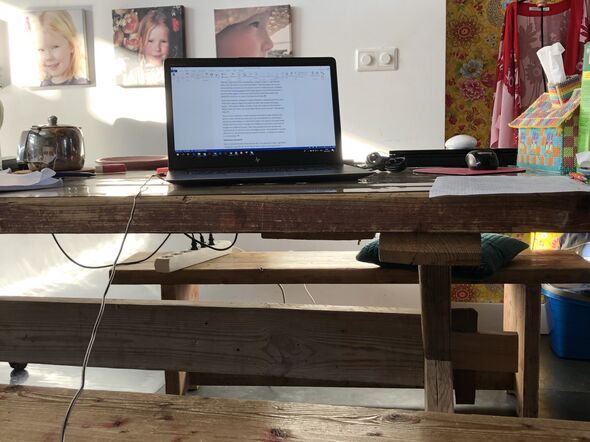Listen to your body - especially when working from home
Now that the vast majority of the TU/e community is working or studying from home, we are at risk of developing problems with our arms, neck, shoulders and lower back. TU/e's own Occupational Health and Safety organization is therefore offering exercises for people working from home and has five golden tips.
“The likelihood that people will develop problems is now greater, that much is certain,” says Marcel Vliex, occupational health and environment consultant with AMVS. “Even though we are in an exceptional situation, we want to continue preventing and reducing the symptoms people have. We have therefore posted exercises on our intranet page for people working from home.” On the same page you will find a huge amount of information about arm, neck and shoulder/RSI symptoms and what you can do to combat them.
Because there's no doubt about it, warns Vliex, a number of us are bound to develop these symptoms. Take a good look at your own home-working situation; it would very likely not pass a health & safety test. “The current situation is far from ideal but we will all have to make the best of it. Pay close attention to your work space and your posture, and listen to your body,” Vliex says emphatically.
This Cursor editor would be the first to admit she has room for improvement: I am now working on my laptop for the third straight week seated on a wooden bench at my dining table. And I admit that I am working (many) more hours than I usually would, seated safely on my height adjustable office chair, at my height adjustable desk, with two screens and a separate keyboard. And those oh so necessary breaks - homeworkers should take a five-minute break every half hour - are so easily forgotten. Sound familiar?
Driven people
To some extent, these risks are inherent in the TU/e community, says Vliex. “Our organization's great strength is that it is staffed by very driven people. Who are often inclined to push on without taking a break.”
Problems with arms, neck, shoulders and back often arise because after a while our posture becomes cramped without our noticing. This creates blockages in the body that hinder the circulation of oxygen, nutrients and body toxins. Added to which, in the current situation most people are probably experiencing (added) stress. This causes the body to produce more toxins and the likelihood of problems then increases. “Actually you should set an alarm to go off every half hour. A trigger to leave your work space for five minutes to take an active break. Go into the garden, or do stretching exercises on your balcony,” advises Vliex.
Keep moving
As well as the exercises and information provided by AMVS, it is also worth taking a look at the videos the Student Sports Centre is making for home workouts, Vliex recommends. “Initiatives like this typify this organization's added value: everyone contributes their own little bit of expertise. The net result is that together we can do this.”
He emphasizes that self-discipline makes the difference between failure and success. “People must set up their work space as best they can using the resources to hand, they must watch their own behavior in terms of taking breaks closely, listen to their body, and at the first sign of symptoms, take appropriate action.”
He knows from experience that it is difficult to take a break when you are deep in concentration. “That's when you ignore your body's signals. It is always the biggest challenge.”
Vliex concludes by giving not only some extra tips for working from home safely and over the longer term but also five top tips for homeworkers:
1: Listen to your body.
2: Take a break every half hour and move around to get the blood flowing.
3: Make sure you do things that lower stress: enjoy what you have together. Being at home together provides a healthy basis.
4: Be kind to each other and tolerant.
- 5: Go outside if you can: sunshine boosts your energy!



Discussion